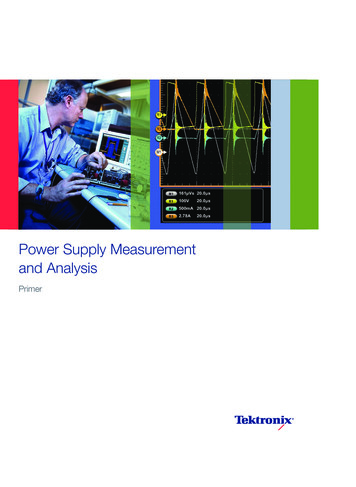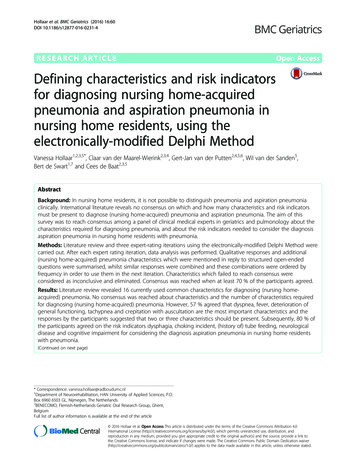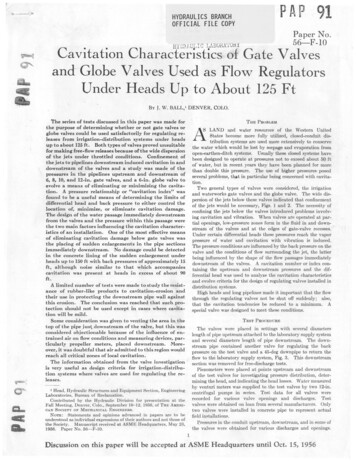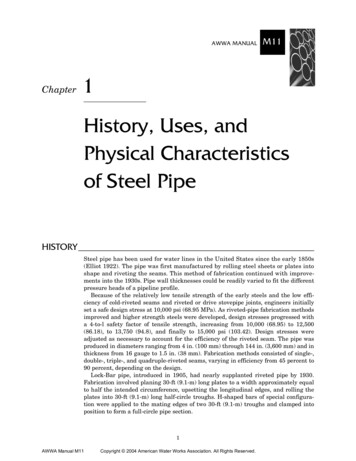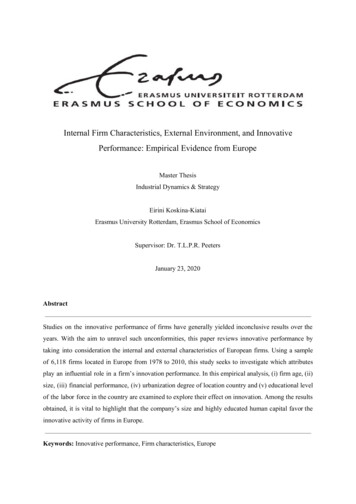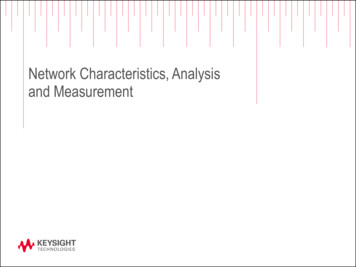
Transcription
Network Characteristics, Analysisand Measurement
Agenda– Transmission Lines– S-Parameters– The Smith Chart– Network Analyzer Block Diagram– Network Analysis Measurements– Calibration and Error CorrectionPage 2
RF Energy UTRFPage 3
Transmission Line BasicsLow frequencies I– Wavelengths wire length– Current (I) travels down wires easily for efficient power transmission– Measured voltage and current not dependent on position along wireHigh frequencies– Wavelength » or length of transmission medium– Need transmission lines for efficient power transmission– Matching to characteristic impedance (Zo) is very important for low reflectionand maximum power transfer– Measured envelope voltage dependent on position along linePage 4
Transmission line Zo–Zo determines relationship between voltage and current waves–Zo is a function of physical dimensions and r–Zo is usually a real impedance (e.g. 50 or 75 ohms)Page 5
Power Transfer EfficiencyRSFor complex impedances, maximumpower transfer occurs when ZL ZS*(conjugate match)RLRs jXLoad 0RL / RSMaximum power is transferred when RL RSPage 6
Transmission Line Terminated with ZoZs ZoZo characteristic impedanceof transmission lineZoVincVreflect 0! (all the incident poweris transferred to andabsorbed in the load)For reflection, a transmission line terminated in Zo behaveslike an infinitely long transmission linePage 7
Transmission Line Terminated with Short, OpenZs ZoV incoVreflect In-phase (0 ) for open,oout-of-phase (180 ) for shortFor reflection, a transmission line terminated in a short oropen reflects all power back to sourcePage 8
Transmission Line Terminated with 25 OhmsZs ZoZL 25 WVincVreflectStanding wave pattern does notgo to zero as with short or openPage 9
Reflection ParametersReflection Coefficient [S11]Return loss -20 log(r ), GrVreflected Vincident rF ZL - ZoZL ZoGVoltage Standing Wave RatioVmaxVminVSWR VmaxVmin 1 r1-rFull reflection(ZL open, short)No reflection(ZL Zo)0r1 dBRL0 dB1VSWR Page 10
Transmission ParametersV IncidentPort 1V TransmittedDUTTransmission Coefficient [S21] Insertion Loss (dB) -20 LogPort 2T V IncidentVTransV IncGain (dB) 20 LogV TransV IncV Transmitted -20 Log( ) 20 Log( )Page 11
Demonstration:Page 12
Agenda– Transmission Lines– S-Parameters– The Smith Chart– Network Analyzer Block Diagram– Network Analysis Measurements– Calibration and Error CorrectionPage 13
High-Frequency Device NSMISSIONREFLECTIONReflectedIncident VSWRS-ParametersS11, S22ReflectionCoefficientG, rATransmittedRIncidentReturn LossImpedance,AdmittanceR jX, G jB Gain / LossS-ParametersTransmissionS21, S12CoefficientT,tBRGroup DelayInsertionPhasePage 14
Characterizing Unknown DevicesUsing parameters (H, Y, Z, S) to characterize devices:– Gives linear behavioral model of our device– Measure parameters (e.g. voltage and current) versus frequency undervarious source and load conditions (e.g. short and open circuits)– Compute device parameters from measured data– Predict circuit performance under any source and load conditionsH-parametersV1 h11I1 h12V2I2 h21I1 h22V2Y-parametersI1 y11V1 y12V2I2 y21V1 y22V2Z-parametersV1 z11I1 z12I2V2 z21I1 z22I2h11 V1I1V2 0(requires short circuit)h12 V1V2I1 0(requires open circuit)Page 15
Why Use Scattering, S-Parameters?– Relatively easy to obtain at high frequencies Measure voltage traveling waves with a vector network analyzer Don't need shorts/opens (can cause active devices to oscillate or self-destruct)– Relate to familiar measurements (gain, loss, reflection coefficient .)– Can cascade S-parameters of multiple devices to predict system performance– Can compute H-, Y-, or Z-parameters from S-parameters if desired– Can easily import and use S-parameter files in electronic-simulation toolsa1S 21Incidentb2S11Reflectedb1TransmittedDUTPort 1TransmittedPort 2S12S22Reflecteda2Incidentb1 S11 a1 S12 a 2b 2 S21 a1 S22 a 2Page 16
Measuring S-Parametersa1ForwardS 21 b1Incidenta2 0b1 a1ba2 02 a1a2 0a1 ed21Z0S 11ReflectedIncidentS 11 SIncidentTransmittedS 12S 22 S 12 ReflectedIncidentTransmittedIncidentS 22b2 a2ba1 01 a2a1 0b2ReverseReflecteda2IncidentPage 17
Equating S-Parameters With Common MeasurementTermsPort 1DUTPort 2S11 forward reflection coefficient (input match)S22 reverse reflection coefficient (output match)S21 forward transmission coefficient (gain or loss)S12 reverse transmission coefficient (isolation)Page 18
Demonstration4 S-Parameters with Correction OffPage 19
Demonstration4 S-Parameters with Correction OnPage 20
Agenda– Transmission Lines– S-Parameters– The Smith Chart– Network Analyzer Block Diagram– Network Analysis Measurements– Calibration and Error CorrectionPage 21
Smith Chart ReviewPolar plane90o jX1.0.8.6.40 180 o- R o.20 0-jX-90 oRectilinear impedance planeInductiveConstant XConstant RZ L ZoSmith Chart maps rectilinearimpedance plane ontopolar planeG 0ZL Z L 0 (short)G 1 180G 1O(open)0OCapacitiveSmith ChartPage 22
Demonstration: Smith ChartShort, and Open, and a Matched ImpedancePage 23
Agenda– Transmission Lines– S-Parameters– The Smith Chart– Network Analyzer Block Diagram– Network Analysis Measurements– Calibration and Error CorrectionPage 24
Generalized Network Analyzer Block Diagram(Forward Measurements IVER / DETECTORPROCESSOR / DISPLAYPage 25
EPARATIONINCIDENT (R)REFLECTED(A)TRANSMITTED(B)RECEIVER / DETECTOR– Supplies stimulus for systemPROCESSOR / DISPLAY– Can sweep frequency or power– Traditionally NAs had one signal source– Modern NAs have the option for a secondinternal source and/or the ability to controlexternal source Can control an external source as a localoscillator (LO) signal for mixers andconvertersUseful for mixer measurements likeconversion loss, group delayPage 26
Signal SeparationIncidentTransmittedDUT– Measure incident signal for referenceReflectedSOURCESIGNALSEPARATION– Separate incident and reflected signalsINCIDENT (R)REFLECTED(A)TRANSMITTED(B)RECEIVER / DETECTORPROCESSOR / t PortPage 27
Directional Couplerundesired reverse leakagedesired coupledsignaldesired through signalPage 28
DirectivityDirectivity is a measure of how well a directional coupler or bridge can separatesignals moving in opposite directions(undesired leakagesignal)(desired reflectedsignal)IleakagedesiredCresultTest portLDirectional CouplerDirectivity Isolation (I) - Fwd Coupling (C) - Main Arm Loss (L)Page 29
Interaction of Directivity with the DUT (Without ErrorCorrection)0Data maxDirectivity30Add in-phaseDevice60FrequencyData minDeviceDeviceDirectivityDirectivityReturn LossDUT RL 40 dBData vector sumAdd out-of-phase(cancellation)Page 30
LSEPARATIONTuned ReceiverINCIDENT (R)IF F LO F RFRFADC / DSPREFLECTED(A)TRANSMITTED(B)RECEIVER / DETECTORPROCESSOR / DISPLAYIF FilterLOVector narrowband(magnitude and phase)Page 31
Detector:Narrowband Detection - Tuned ReceiverRFADC / DSPIF Filter– Best sensitivity / dynamic range– Provides harmonic / spurious signal rejectionLO– Improve dynamic range by increasing power,decreasing IF bandwidth, or averaging– Trade off noise floor and measurement speed10 MHz26.5 GHzPage 32
Dynamic Range and AccuracyError Due to Interfering Signal100-10Error (dB, deg) phase error1Dynamic range isvery important formeasurementaccuracy!magn -60-65-70Interfering signal or noise (dB)RF Back to BasicsPage 33
DemonstrationVNA - 2 port Block DiagramPageVNA Block DiagramsPage 34
Processor / EIVER / DETECTORPROCESSOR / DISPLAY– Markers– Limit lines– Pass/fail indicators– Linear/log formats– Grid/polar/Smith charts– Time-domain transform– Trace mathPage 35
Agenda– Transmission Lines– S-Parameters– The Smith Chart– Network Analyzer Block Diagram– Network Analysis Measurements– Calibration and Error CorrectionPage 36
Why Do We Need to Test Components?– Verify specifications of “building blocks”for more complex RF systems– Ensure distortion-free transmissionof communications signals Linear: constant amplitude, linear phase / constant group delay Nonlinear: harmonics, intermodulation, compression, X-parameters– Ensure good match when absorbingpower (e.g., an antenna)KPWR FM 97Page 37
The Need for Both Magnitude and PhaseS211. Complete characterizationof linear networksS11S22S124. Time-domain characterization2. Complex impedanceneeded to designmatching circuitsMagTime3. Complex valuesneeded for devicemodeling5. Vector-error correctionErrorMeasuredActual6. X-parameter (nonlinear) characterizationPage 38
Linear Versus Nonlinear BehaviorA * Sin 360o * f (t - to)ATimetoSin 360o * f * tAphase shift to * 360o * fTimeDUTInputf1f1FrequencyLinear behavior: Input and output frequencies are thesame (no additional frequenciescreated) Output frequency only undergoesmagnitude and phase changeOutputFrequencyTimef1Nonlinear behavior: Output frequency mayundergo frequency shift (e.g.with mixers) Additional frequencies created(harmonics, intermodulation)FrequencyPage 39
Phase Variation with FrequencyF(t) sin wt 1 /3 sin 3wt 1 /5 sin 5wtLinear NetworkTimeMagnitudeTimeFrequency0 Frequency-180 Frequency-360 Page 40
Deviation from Linear PhaseUse electrical delay to remove linearportion of phase responseLinear electricallength addedPhase 45 /DivRF filter responseDeviation from linearphaseooPhase 1 /Div(Electrical delay function) FrequencyLow resolutionFrequencyFrequencyHigh resolutionPage 41
Group DelayFrequency (w)tgGroup delay rippleDwtoPhase Average delayD FrequencyGroup Delay (tg)-d dw w -1360 o*d dfin radiansin radians/sec Group-delay ripple indicates phase distortion Average delay indicates electrical length of DUT Aperture (Dw) of measurement is very importantin degreesf in Hertz (w 2 p f)Page 42
PhasePhaseWhy Measure Group Delay?ff-d dwGroupDelayGroupDelay-d dwffSame peak-peak phase ripple can result in different group delayPage 43
Why the Time Domain?RF Back to Basics44Page 44
Frequency Domain S11 Response of SemirigidCoax CableUpperLimitrFrequencyRF Back to Basics45Page 45
Time Domain S11 Response of Semirigid Coax CablerTimeRF Back to Basics46Page 46
Fault Location Range Example: 10m cableEffects of Changing Frequency SpanBand Pass Mode, 401 Points, Span changed from 5.0 GHz to 2.5GHz Range 160 ns (48 m)S11LINEARREF 0.0 Units10.0 mUnits/S11LINEARREF 0.0 Units1 10.0 mUnits/Ñ 610.17 mUMARKER 1160.0 ns47.967 mSTART 0.0 sSTOP 75.0 ns5 GHz Span2.5 GHz SpanSTART 0.0 sSTOP 250.0 nsRF Back to BasicsPage 47
Gain CompressionDUT Parameter to define the transition between the linear and nonlinear region of anactive device. The compression point is observed as x dB drop in the gain with VNA’s power sweep.Gain (S21)Output Power (dBm)Sufficient powerlevel to drive DUTLinear regionCompression(nonlinear) regionInput Power (dBm)Power is not high enoughto compress DUT.Input Power (dBm)Enough margin of source power capabilityis needed for analyzers.Page 48
Gain Compression Measurement ExampleCh 1 (vs. Input power):Tr 1: Gain Compresssion vs. PinTr 2: Pout vs. PinCh 2 (vs. Frequency):Tr 1: Pin @ P1dB vs. FreqTr 2: Pout @ P1dB vs. FreqRF Back to BasicsPage 49
Multiport MeasurementApplication Examples RF front end modules / antennaswitch modules Channel measurements of MIMOantennasTx AntennaRx AntennaSWhmnSW: Interconnects (ex. cables,connectors) General-purpose multiport devicesPage 50:
Agenda– Transmission Lines– S-Parameters– The Smith Chart– Network Analysis Measurements– Calibration and Error CorrectionPage 51
The Need For Calibration– Why do we have to calibrate? It is impossible to make perfect hardware It would be extremely difficult and expensive to make hardware goodenough to entirely eliminate the need for error correction– How do we get accuracy? With vector-error-corrected calibration Not the same as the yearly instrument calibration– What does calibration do for us? Removes the largest contributor to measurementuncertainty: systematic errorsSystematic error Provides best picture of true performance of DUTPage 52
Measurement Error Modeling– Systematic errors Due to imperfections in the analyzer and test setup Assumed to be time invariant (predictable) Generally, are largest sources or error– Random errors Vary with time in random fashion (unpredictable) Main contributors: instrument noise, switch and connectorrepeatability– Drift errors Due to system performance changingafter a calibration has been doneErrors:SYSTEMATIC Primarily caused bytemperature variationMeasuredDataRANDOMUnknownDeviceDRIFTPage 53
Systematic Measurement ErrorsRDirectivityABCrosstalkDUTFrequency response Reflection tracking (A/R) Transmission tracking (B/R)SourceMismatchLoadMismatchSix forward and six reverse error terms yields 12error terms for two-port devicesPage 54
Types of Error Correction– Response (normalization)thru Simple to perform Only corrects for tracking (frequency response) errors Stores reference trace in memory, then does data divided by memory– Vector Requires more calibration standards Requires an analyzer that can measure phase Accounts for all major sources of systematic errorSHORTOPENS11athruS11 mLOADPage 55
What is Vector-Error Correction?– Vector-error correction Is a process for characterizing systematic error terms Measures known electrical standards Removes effects of error terms from subsequentmeasurementsErrorsMeasuredActual– Electrical standards Can be mechanical or electronic Are often an open, short, load, and thru,but can be arbitrary impedances as wellPage 56
Using Known Standards to Correctfor Systematic Errors– 1-port calibration (reflection measurements)Only three systematic error terms measuredDirectivity, source match, and reflection tracking – Full two-port calibration (reflection and transmission measurements)Twelve systematic error terms measuredUsually requires 12 measurements on four known standards (SOLT) – Standards defined in cal kit definition fileNetwork analyzer contains standard cal kit definitionsCAL KIT DEFINITION MUST MATCH ACTUAL CAL KIT USED!User-built standards must be characterized and entered into user cal-kit Page 57
Reflection: One-Port ModelRF inIdealError AdapterRF in1ED DirectivityS11AS11MESEDS11MERTTo solve for error terms, wemeasure 3 standards to generate3 equations and 3 unknownsS11AERT Reflection trackingES Source MatchS11M MeasuredS11A ActualS11AS11M ED ERT1 - ES S11A– Assumes good termination at port two if testing two-port devices– If using port two of NA and DUT reverse isolation is low (e.g., filter passband):Assumption of good termination is not validTwo-port error correction yields better results RF Back to Basics58Page 58
Before and After A One-Port CalibrationData after 1-port calibrationData before 1-port calibrationPage 59
Two-Port Error CorrectionReverse modelForward modelPort 1a1EDEXS11Ab1E RTS22 AS 12ETTELb2S11Ab2AS22 AE S'ED'a2S12 AE TT'EX'AE D' rev directivityE S' rev source matchE RT' rev reflection trackingEL' rev load matchETT' rev transmission trackingEX' rev isolation E L'b1a2EL fwd load matchETT fwd transmission trackingEX fwd isolation S21a1ED fwd directivityE S fwd source matchERT fwd reflection tracking Port 2E RT'Port 2S21AESPort 1Each actual S-parameter is a function ofall four measured S-parametersAnalyzer must make forward and reversesweep to update any one S-parameterLuckily, you don't need to know theseequations to use a network analyzers!!!S11a S- EDS- ED 'S- E X S12 m - E X '( 11m)(1 22mE S ' ) - E L ( 21m)()E RTE RT 'E TTE TT 'SSS- E D'- ED '- E X S12m - E X '(1 11mE S )(1 22mE S ' ) - E L ' E L ( 21m)()E RTE RT 'E TTETT 'S21a S21m - E XS22 m - E D ')(1 ( E S '- E L ))E TTE RT 'SSS- ED- ED'- E X S12 m - E X '(1 11mE S )(1 22mE S ' ) - E L ' E L ( 21m)()E RTE RT 'E TTETT 'S12a S- EX 'S- ED( 12m)(1 11m( E S - E L ' ))E TT 'E RTS- EDS- ED'S- E X S12m - E X '(1 11mE S )(1 22mE S ' ) - E L ' E L ( 21m)()E RTE RT 'E TTE TT 'S22a S 22m - E D 'S11m - E DS 21m - E X S12m - E X ')( 1 ES ) - E L ' ()()E RT 'E RTE TTE TT 'S- EDS- ED'S- E X S12m - E X '(1 11mE S )(1 22mE S ' ) - E L ' E L ( 21m)()E RTE RT 'E TTETT '((Page 60
ECal: Electronic Calibration– Variety of two- and four-port modules cover 300 kHz to 67 GHz– Nine connector types available, 50 and 75 ohms– Single-connection calibration dramatically reduces calibration time makes calibrations easy to perform minimizes wear on cables and standards eliminates operator errors– Highly repeatable temperature-compensatedcharacterized terminations provide excellent accuracyUSB ControlledMicrowave modules use atransmission line shuntedby PIN-diode switches invarious combinationsPage 61
Errors and Calibration StandardsUNCORRECTEDFULL 2-PORTRESPONSE1-PORTSHORTDUTOPENthru ConvenientGenerally not accurateNo errors removedLOADSHORTOPENOPENLOADLOADDUT Easy to performUse when highestaccuracy is notrequiredRemoves frequencyresponse errorENHANCED-RESPONSECombines response and 1-port Corrects source match for transmissionmeasurements SHORTDUT For reflection measurementsNeed good termination forhigh accuracy with two-portdevicesRemoves these errors:DirectivitySource matchReflection trackingthruDUT Highest accuracyRemoves theseerrors:DirectivitySource, load matchReflection trackingTransmissiontrackingCrosstalkPage 62
DemonstrationVNA showing Band Pass FilterUncalibrated, Response Cal and Full 2 port calibrationPage 63
Wrap-Up– Transmission Lines– S-Parameters– The Smith Chart– Network Analysis Measurements– Calibration and Error CorrectionPage 64
For more information,www.keysight.com/find/naPage 65
Generalized Network Analyzer Block Diagram (Forward Measurements Shown) RECEIVER / DETECTOR PROCESSOR / DISPLAY REFLECTED (A) TRANSMITTED (B) INCIDENT (R) SIGNAL SEPARATION SOURCE . RF Back to Basics Page 47 S 11 LINEAR REF 0.0 Units 1 10.0 mUnits/ Ñ 610.17 mU S 11 LINEAR 10.0 mUnits



